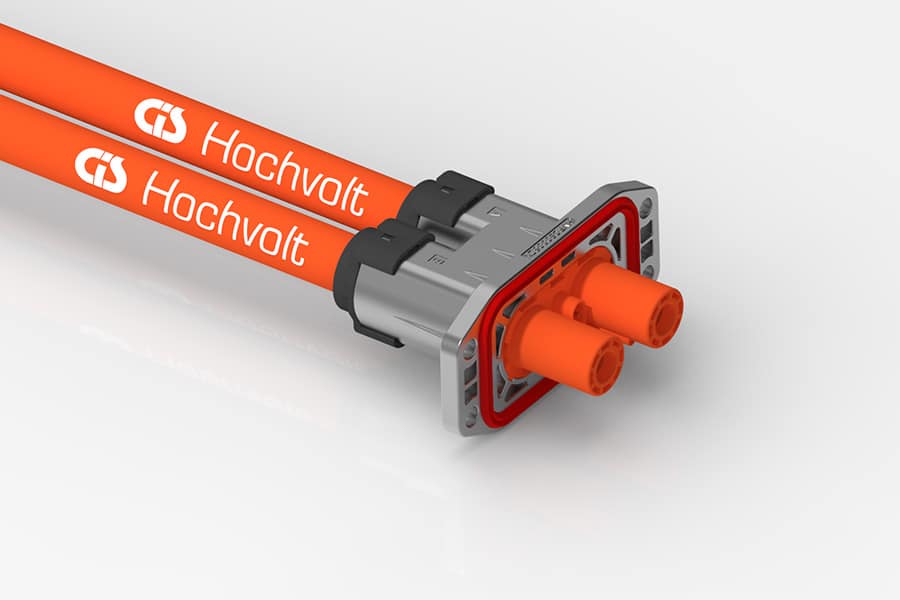With the high-voltage cable assemblies from CiS you are on the safe side!
In times of electric mobility and hybrid drives, high-voltage cables are becoming increasingly important. They are an important component of electric and hybrid vehicles and enable invisible power transmission between the individual components. Let us support the vision of a green vehicle electrical system together and promote more environmentally friendly mobility with our high-voltage cables.
With over 45 years of experience, we are your expert when it comes to processing high-voltage cable assemblies. Our expert consultants accompany you from the initial idea to series production. In cooperation with our customers, we develop and manufacture individual solutions. When it comes to cable assembly, we can process components from all manufacturers currently on the market.
Are you facing a new challenge and looking for a stable partner at your side? – Then CiS is the right place for you!
But what exactly are high-voltage cables? The term high-voltage system comes from automotive engineering and describes a system that is operated with alternating voltages above 30V to 1kV or with direct voltages above 60V to 1.5kV.
A „high-voltage battery“ (400V to 800V) or „high-voltage storage“ is an electrical energy source for mobile and stationary applications. When used in vehicles, it is also referred to as a traction battery.
High-voltage cables are used to transmit high electrical voltages that are required in electric vehicles and hybrid vehicles to supply the electrical drive components. They transport the current from the battery to the motor, the generator and the other electrical consumers in the vehicle. Despite their high performance, high-voltage cables are particularly space- and weight-saving due to their innovative design, which enables electric vehicles to have a longer range and supports CO2 regulation.
It should be noted that high-voltage connectors are used in this area. As connectors establish the electrical connection between electronic high-voltage components, maximum safety is required here.
Through our careful and conscientious electrical testing, we guarantee you above all reliability and safety at the highest level of quality. Would you like to gain a short insight into the electrical testing in our production halls? Then we invite you to take our virtual tour.


High-voltage cables consist of different layers that are crucial for their function. The outer layer is an insulation layer that protects the cable from moisture, dust and other environmental influences.
Underneath is a shield that reduces electromagnetic interference and stabilises the current flow. In the middle of the cable is the actual conductor, which is made of copper or aluminium and transports the current. Depending on the requirements, several conductors can be installed in one cable.

High-voltage cables must meet various requirements to be suitable for use in electric cars and hybrid vehicles. These include:
With know-how and comprehensive expertise, CiS develops and produces individual solutions for high-voltage connections – naturally in accordance with the highest quality standards, such as the norms and standards of the VDA. Get in touch with us now.
In addition to high-voltage cables, we supply you with other products of the highest quality. We are also there for you when it comes to cable assembly, electromechanical components, system technology, input systems and development services.
High-voltage cables are mainly used in electric cars and hybrid vehicles. There, they transport the current between the electrical components. In addition to their function in electric and hybrid vehicles, high-voltage cables are also used in other applications, such as power engineering and industry. Here, for example, they are used to transport direct current or alternating current. High-voltage cables are also used in fuel cells, high-voltage batteries and electrified wiring systems, where they ensure efficient energy transmission.
High-voltage cables are used wherever vehicles need to be electrically driven, such as:
he main difference between a high-voltage cable and a low-voltage cable is the voltage that is transported. High-voltage cables carry voltages in the range of several hundred to 1,000 volts, while low-voltage cables only carry voltages of up to 50 volts. As a result, there are specified safety regulations for high-voltage cables which must be observed.
Are you looking for a competent partner with experience in the high-voltage sector? – Then please contact our technical advisors. We look forward to your enquiry!
Copyright © 2023 CiS electronic GmbH. Alle Rechte vorbehalten.
We use cookies on our website. Some of them are essential, while others help us improve this website and your experience. Wenn Sie unter 16 Jahre alt sind und Ihre Zustimmung zu freiwilligen Diensten geben möchten, müssen Sie Ihre Erziehungsberechtigten um Erlaubnis bitten. Wir verwenden Cookies und andere Technologien auf unserer Website. Einige von ihnen sind essenziell, während andere uns helfen, diese Website und Ihre Erfahrung zu verbessern. Personenbezogene Daten können verarbeitet werden (z. B. IP-Adressen), z. B. für personalisierte Anzeigen und Inhalte oder Anzeigen- und Inhaltsmessung. Weitere Informationen über die Verwendung Ihrer Daten finden Sie in unserer privacy policy. Sie können Ihre Auswahl jederzeit unter Einstellungen widerrufen oder anpassen.
Wenn Sie unter 16 Jahre alt sind und Ihre Zustimmung zu freiwilligen Diensten geben möchten, müssen Sie Ihre Erziehungsberechtigten um Erlaubnis bitten. Wir verwenden Cookies und andere Technologien auf unserer Website. Einige von ihnen sind essenziell, während andere uns helfen, diese Website und Ihre Erfahrung zu verbessern. Personenbezogene Daten können verarbeitet werden (z. B. IP-Adressen), z. B. für personalisierte Anzeigen und Inhalte oder Anzeigen- und Inhaltsmessung. Weitere Informationen über die Verwendung Ihrer Daten finden Sie in unserer privacy policy. Here you can find an overview of all cookies used. You can give your consent to entire categories or view more information and thus select only certain cookies.